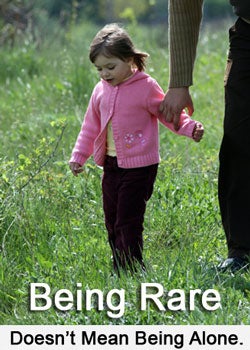
Crowdfunding is starting to accomplish some pretty impressive feats beyond video game reboots and smartphone-linked watches on Kickstarter. In mid-July, the nonprofit organization Rare Genomics Institute (RGI), which sequences genomes of children with rare genetic diseases, announced that it had identified a previously unknown gene variant in 4-year-old Maya Nieder’s genome that is believed to be responsible for her global developmental delays. Through RGI, Maya’s parents were able to crowdsource the funds needed for her sequencing to be completed.
According to a press release, it’s the first crowdfunded gene discovery, something RGI wants to make much more common.
Maya’s developmental issues have caused her to be unable to speak or run and she has difficulty hearing. She’s been seen by a handful of doctors and been through two operations, including the insertion of ear tubes and the removal of her adenoids, yet her condition remained a mystery. Multiple genetic screens for known defects yielded nothing definitive, even after 3.5 years.
When Maya’s parents posted her profile on RGI’s website in December, the funding goal for the sequencing was only $2,500, but within 6 hours, 50 donors had raised a total of $3,550. At the beginning of July, researchers at Yale had completed sequencing Maya’s exome (the protein-coding portion of the genome), which was about 20,000 genes (per Talking Points Memo). The findings suggested that Maya had a spontaneous mutation that occurred sometime after conception on a gene that was believed to be developmentally significant, and that mutation caused no functional protein to be produced.
Now that the researchers have identified the gene variant in Maya’s genome, they can study the missing protein to better understand how its absence impacts development, allowing doctors greater insight into how they may best treat Maya and direct her parents with her therapy. In the meantime, Maya’s mother Dana has written about the whole process on her blog, Uncommon Sense.
Maya is one of 10 children with rare disease who are part of RGI’s pilot program to test out the effectiveness of the crowdsourced funding model.

The organization was founded in 2011 by geneticist Jimmy Lin, a research instructor in the Pathology Department at Washington University in St. Louis who was named a 2012 TED fellow and serves as a mentor for this year’s SynBio Startup Launchpad at Singularity University (you can check out an informal talk he gave about RGI here). RGI works by allowing families to profile their children’s condition to raise more for genome sequencing. Once families meet with one of RGI’s patient advocates and the funding goal is met, they will be connected to a geneticist and a researcher in the network of labs, which is currently 10 sites including Duke, John Hopkins, Yale and the National Cancer Institute. It takes up to 12 months for the sequencing and analysis to be completed, at which point the RGI team contacts the families to discuss the results and a course of treatment for the child.
For years, institutions like St. Jude Children’s Research Hospital have raised money to help children in need, and people donate to a general fund that is distributed per the discretion of the organization’s staff. But an organization like St. Jude is enormous, with a staff of 3,600 and a daily operating cost of $1.7 million, most of which is covered through donations. With all the children suffering from known childhood diseases in need of care, it is a challenge for parents of a child with a rare or unknown genetic disease to find support. And that’s where the crowd can be a huge help.
As those who are familiar with Kickstarter know, crowdsourcing involves a much smaller role for the middleman, so that the people who need the funds for a very specific funding goal solicit the site’s userbase for the money. Crowdsourcing has become a household name due to Kickstarter’s success as some projects have pulled in millions of dollars. Wanting to capitalize on this new way of fundraising, RGI entered the fray, but they are not alone. Other organizations, such as Petridish and Medstartr, are seeking to crowdsource advances in science and healthcare, respectively.
Whether crowdsourcing can be a reliable and consistent means of raising money for social good instead of entertainment purposes remains to be seen. But in the meantime, RGI is accomplishing something significant by helping resolve rare genetic diseases through sequencing one child at a time.



